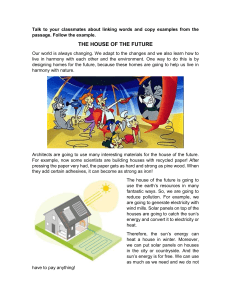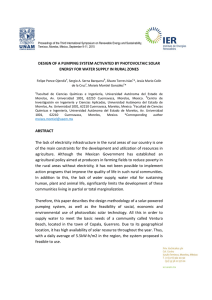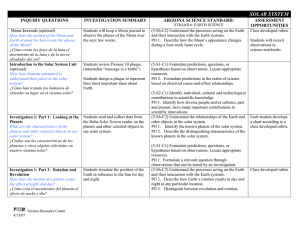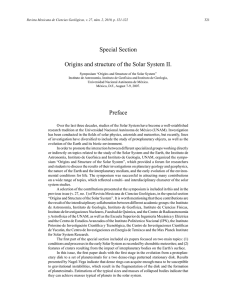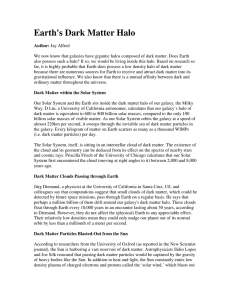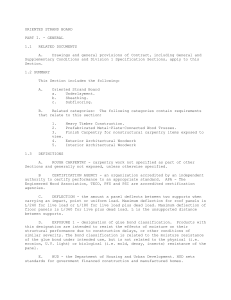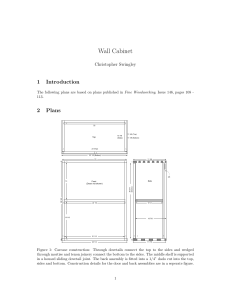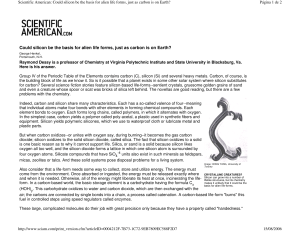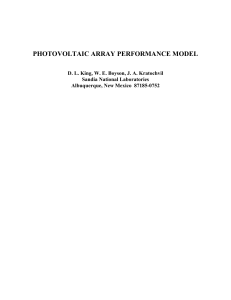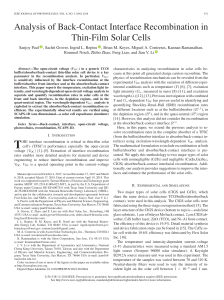Solar Energy - Pearson ELT
Anuncio
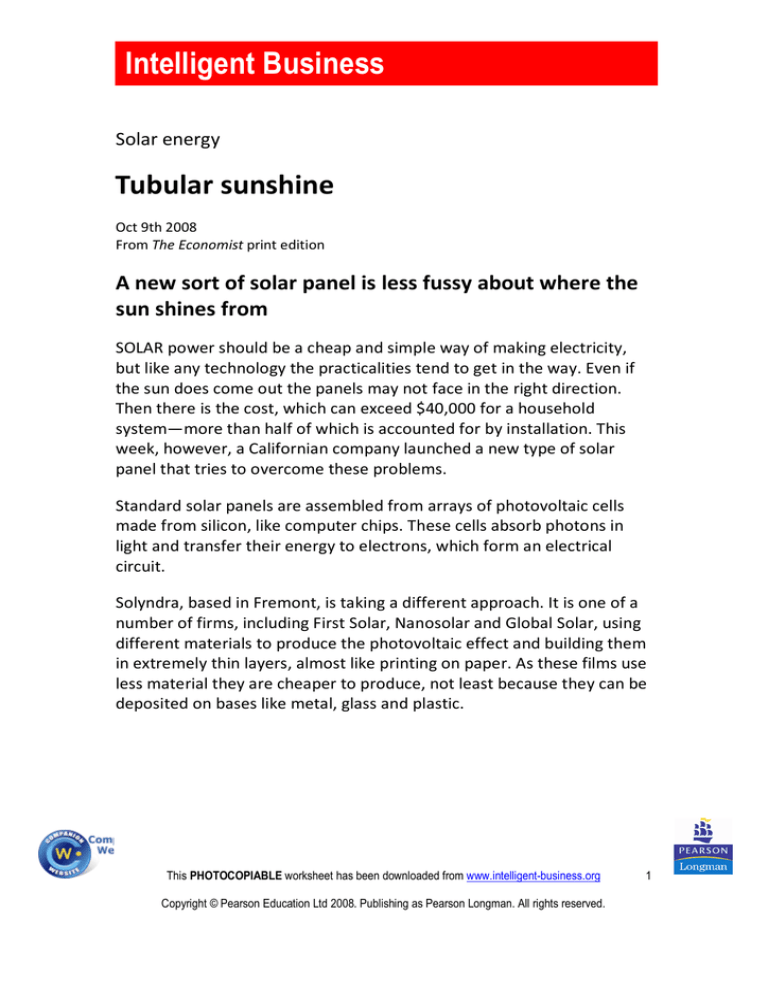
Intelligent Business Solar energy Tubular sunshine Oct 9th 2008 From The Economist print edition A new sort of solar panel is less fussy about where the sun shines from SOLAR power should be a cheap and simple way of making electricity, but like any technology the practicalities tend to get in the way. Even if the sun does come out the panels may not face in the right direction. Then there is the cost, which can exceed $40,000 for a household system—more than half of which is accounted for by installation. This week, however, a Californian company launched a new type of solar panel that tries to overcome these problems. Standard solar panels are assembled from arrays of photovoltaic cells made from silicon, like computer chips. These cells absorb photons in light and transfer their energy to electrons, which form an electrical circuit. Solyndra, based in Fremont, is taking a different approach. It is one of a number of firms, including First Solar, Nanosolar and Global Solar, using different materials to produce the photovoltaic effect and building them in extremely thin layers, almost like printing on paper. As these films use less material they are cheaper to produce, not least because they can be deposited on bases like metal, glass and plastic. This PHOTOCOPIABLE worksheet has been downloaded from www.intelligent-business.org Copyright © Pearson Education Ltd 2008. Publishing as Pearson Longman. All rights reserved. 1 Intelligent Business The most effective material for thin-film photovoltaics so far is copper indium gallium selenide (known as CIGS). Although it is not quite as efficient at converting sunlight into electricity as silicon is, its low cost and flexibility provide other advantages. Solyndra’s approach is to coat glass tubes with CIGS and encase them in another glass tube with sealed ends. They look a bit like fluorescentlighting tubes. Forty of these tubes are then assembled into a single panel. Using tubes instead of flat panels makes it possible to capture sunlight, including diffuse light, from any direction—even if it is reflected up from a roof. And whereas traditional solar panels have to be tilted and carefully positioned so as not to shade nearby panels, tubular ones can be laid flat over the entire roof. Being lightweight and open they are also less prone to being blown away. This makes them easier and faster to fit. The cost of installation, reckons the company, should be about half that of conventional panels. Solyndra is chasing the market for commercial rooftops: factories, warehouses and supermarkets. Chris Gronet, the company’s chief executive, says that with some 30 billion square feet of large flat roofs in the United States alone, tubular solar cells could generate 150 gigawatts of electricity. That would be enough to power almost 16m homes. This PHOTOCOPIABLE worksheet has been downloaded from www.intelligent-business.org Copyright © Pearson Education Ltd 2008. Publishing as Pearson Longman. All rights reserved. 2 Intelligent Business Tubular sunshine Worksheet exercises General understanding A Read the article and tick the statements which are true. Find evidence in the text to justify your choices. 1. Solar power uses energy from the sun to make electricity. 2. More than 50% of the cost of household solar energy systems derives from the cost of the photovoltaic cells. 3. Standard photovoltaic cells require the sun to be shining and the panels to be facing in the right direction. 4. Computer chips are made from silicon. 5. Photovoltaic cells absorb photons to produce an electric current. 6. Solyndra has tried making photovoltaic cells from other materials. 7. Solyndra is the only firm doing this. 8. Solyndra uses thin layers of photovoltaic materials to print on paper panels. 9. Copper indium gallium selenide (CIGS) is cheaper and more efficient than silicon at converting sunlight into electricity. 10. Solyndra makes photovoltaic panels by coating glass tubes with thin films of CIGS. 11. Each panel contains forty of these tubes. 12. The panels can absorb photons from direct light from different directions and even diffuse or reflected light. 13. The lightweight panels can be laid flat on a roof reducing installation costs. 14. Chris Gronet, the CEO of Solyndra, says that, in the USA, flat roofs fitted with tubular solar panels could generate 150 gigawatts of electricity. 15. This could provide power for more than 16 million homes. This PHOTOCOPIABLE worksheet has been downloaded from www.intelligent-business.org Copyright © Pearson Education Ltd 2008. Publishing as Pearson Longman. All rights reserved. 3 Intelligent Business B Read the questions and choose the correct option. Find evidence in the text to justify your choices. 1. What is the main problem associated with standard solar panels? a. They get in the way. b. They are made from silicon. c. They require direct sunlight. Why is it so expensive to fit solar panels? a. Because it can exceed $40,000. b. Because it costs a lot to install them. c. Because the panels are not efficient. How do standard solar panels produces electricity? a. They contain silicon which is warmed by the sun. b. They are assembled from arrays. c. They absorb photons and produce electrons. Where is Fremont? a. In California. b. In Britain. c. In Solyndra. What are First Solar, Nanosolar and Global Solar doing? a. Collaborating with Solyndra. b. Competing with Solyndra. c. Depositing photovoltaic films on metal glass and plastic. What are the two main advantages of CIGS? a. It is cheap and flexible. b. It is more efficient than silicon. c. It can be deposited on metal and plastic. Why do Solyndra use glass tubes? a. So they can encase them in other glass tubes. b. So they can look like fluorescent lighting tubes. c. So they can absorb light from different directions. Why do traditional solar panels have to be tilted? a. So they can receive direct sunlight. b. So they can shade nearby panels. c. So they can be carefully positioned. What is the disadvantage of tilted solar panels? a. They are lightweight. b. They can be easily blown away. c. They can be laid flat over an entire roof. Which market is Solyndra chasing? a. Commercial buildings with large flat roofs. b. 16 million homes. c. Only buildings in the United States. 2. 3. 4. 5. 6. 7. 8. 9. 10. This PHOTOCOPIABLE worksheet has been downloaded from www.intelligent-business.org Copyright © Pearson Education Ltd 2008. Publishing as Pearson Longman. All rights reserved. 4 Intelligent Business Vocabulary C fussy Choose words from the box to complete the sentences. tend array practicalities tilted absorb flexibility encase prone conventional 1. Low energy light bulbs are more expensive than ________ tungsten bulbs. 2. Young children are often ______ about their food. 3. The thieves stole an 18th century clock ______ in a glass dome. 4. These days more people _____ to take winter holidays. 5. The tower isn’t vertical, it’s ______. 6. Older people are ______ to household accidents. 7. Most plants ______ water through their roots. 8. The building was illuminated by an ______ of coloured lights. 9. The ______ of living with four babies can be a problem. 10. Getting a car will give you greater ______ in your social life. Discussion D Discuss the following questions. 1. How could an array of solar panels on your roof help you as an individual? 2. How could an array of solar panels on your roof help the environment? 3. Do you think the new kind of solar panel is only suitable for California, or would it also work in your country? 4. Does your country consume more electricity in the daytime or at night? This PHOTOCOPIABLE worksheet has been downloaded from www.intelligent-business.org Copyright © Pearson Education Ltd 2008. Publishing as Pearson Longman. All rights reserved. 5 Intelligent Business Teacher’s Notes Asking learners to justify their answers with reference to the text increases student talking time and leads to more careful reading. A The numbers in brackets refer to line numbers in the text. 1 (15-17), 2 (12), 3 (9-10) 4 (16), 5 (16-17), 6 (18-20), 7 (18-19), 8 (28), 9 (25-26), 10 (28), 11 (30), 12 (31-32), 13 (36-38), 14 (40-43), 15 (43) B The numbers in brackets refer to line numbers in the text. 1c (10), 2b (12), 3c (16-17), 4a (13+18), 5b (18-19), 6a (26-27), 7c (31-32), 8a (10+33), 9b (35), 10a (39-40) C 1 conventional, 2 fussy, 3 encased, 4 tend, 5 tilted, 6 prone, 7 absorb, 8 array, 9 practicalities, 10 flexibility D Open answers This PHOTOCOPIABLE worksheet has been downloaded from www.intelligent-business.org Copyright © Pearson Education Ltd 2008. Publishing as Pearson Longman. All rights reserved. 6
